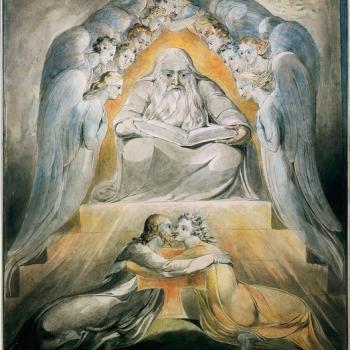Generally speaking, this literature describes a mortal prophetic hero being drawn up into heaven where he undergoes a celestial transformation, participates in the angelic liturgy in the celestial temple, has a vision of God enthroned, receives a revelation of special knowledge, and returns to earth to proclaim this revelation. In the Hebrew Bible itself, theophanies generally occur when God descends from heaven to manifest himself in some way. But there are narratives in the Hebrew Bible that describe a celestial vision or perhaps a heavenly ascent of prophets (Enoch, Gen. 5:21-24; Moses on Sinai/Horeb, Ex. 3, 19, etc.; Micaiah, 1 Kgs. 22:19-22; Elijah, 2 Kgs. 2:10-12; Isaiah, Isa. 6; Ezekiel, Ezek. 1; Daniel, Dan. 7:9-14). Was Jesus denying the validity of these celestial visions? Or was he rejecting the belief that these visions involved the ascent and return of a mortal into heaven, as opposed to visions of heaven by a mortal who remained on earth?
Paradoxically, other New Testament-era Christians claimed to have ascended to heaven, most notably Paul (2 Cor. 12:1-10), and John the Revelator in the book of Revelation. The letter to the Hebrews likewise implies that Jesus ascended into heaven to prepare a way for faithful Christians to follow (Heb. 4:14, 6:19-20). This, however, may refer to a post-mortal one-way ascent of the righteous dead into heaven.
So this leaves us with a question: Is Jesus claiming that ascent into heaven is impossible for mortal men? Most scholars have interpreted the text in this way. On the other hand, the issue may be more subtle than this. Looking at the four "no one/oudeis" sayings in John may help clarify the matter.
- "No one has ever seen God; the only Son/God at the Father's side, he has revealed him" (Jn. 1:18).
- "No one has ascended into heaven except he who descended from heaven, the Son of Man" (Jn. 3:13).
- No one can come to me unless the Father who sent me draws him" (6:44).
- No one comes to the Father except through me" (Jn. 14:6).
It appears that these four passages are all saying the same thing in different ways. No one sees the Father, ascends to heaven (where the Father is), or comes to the Father except through Jesus. Taken together, these "no one/oudeis" statements do not seem to be saying that "no one" can ever ascend to heaven, come to the Father, and see the Father at all. The purpose of the ministry of Jesus is precisely to allow men to come to know God and become one with him. Rather, the point is that no one can do these things except through the Son as mediator and revelator.
In the context of ancient Jewish and Christian ascent literature, this seems to be a rejection of claims of heavenly ascent through celestial mediators other than Jesus, rather than a rejection of the possibility of heavenly ascent at all. Indeed, John 14:1-7—which I will discuss in detail later—says exactly this, that Jesus is going to ascend to the Father to prepare a way and place for the disciples to likewise ascend to the Father, though perhaps after death. Jesus has come precisely to reveal these "heavenly things" (epourania) (Jn. 3:12). The "no one/oudeis" statements are thus not claiming an utter impossibility of celestial ascent or vision of the Father, but their impossibility without the mediation of the Son.
Dualism
Chapter 3 also introduces the phenomena of dualism in John's gospel. Dualism is the conceptual division of the universe into opposite pairs, one good and one evil. The essence of the dualistic worldview is the struggle between God and the Devil, but it manifests itself in all aspects of life, politics, ethics, and the world of the mind and spirit. Such a dualistic worldview is fundamental to John, and in John 3 we find a number of contrasting dualistic pairs:
- Flesh vs. Spirit (3:6)
- Earthly things vs. Heavenly things (3:12)
- Darkness vs. Light (3:19)
There are other dualisms in John as well, and I'll examine some of them in greater detail later in my explorations. At this point we should simply note that such dualism is a constant theme in John, and they are drawn from the cosmic struggle between Jesus and Satan for the world/kosmos.
The World/Kosmos (3:16-19)
John 3:16-19 reintroduces the idea of the world/kosmos, which is first mentioned in John 1:9 and 1:29. This is a key concept in John and must be properly contextualized in its first-century setting to accurately understand what John is saying. What is the kosmos, and how would first-century Jews have understood this idea?
Kosmos is a Greek word with a primary meaning of "adornment or beautification," from which our English term cosmetics derives. However, its extended meaning is to "organize or arrange," and from that it comes to mean "that which is ordered and beautified by God," that is, God's created order, or the world. The Greek kosmos is thus the obvious origin for our word cosmos, meaning the universe. The term appears rarely in the Septuagint, never consistently translating a single Hebrew word. Kosmos is generally translated as "world," in the sense the earth and its inhabitants, but generally not including the heavens in its New Testament usage. For example, Christ proclaimed: "I came from the Father and have come into the kosmos, and now I am leaving the kosmos and going to the Father" (Jn. 16.28), implying that heaven, where the Father dwells, is not part of the kosmos.





